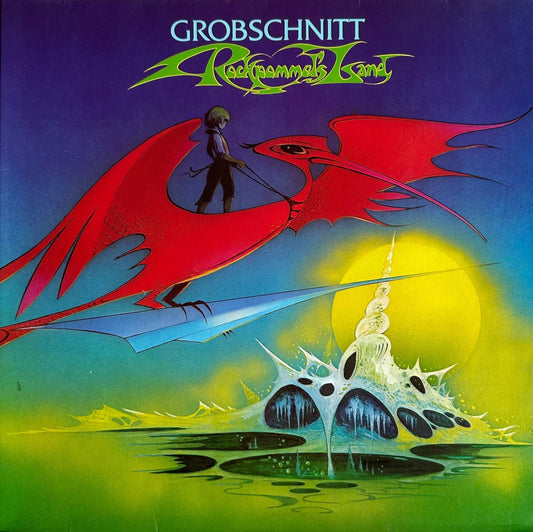Deep Purple was originally called Roundabout because its founder, drummer Chris Curtis, planned to have its personnel be established musicians from other groups, who would come and go like cars on a roundabout. That wasn’t exactly what happened, although Deep Purple has had its share of member turnover during its 51-year history (the four basic lineups are known to serious fans as Marks I-IV). With 20 studio albums and over 35 live albums, this approach seems to have worked out fine.
Curtis ended up not sticking with his own idea, so the debut album by this English band includes Hammond organist Jon Lord, guitarist Ritchie Blackmore, singer Rod Evans, bassist Nick Simper, and drummer Ian Paice. Shades of Deep Purple (1968) is a mix of prog rock and psychedelia, not yet the hard rock and heavy metal sound that would bring the band big success.
Amid the mixture of original and cover material, “Love Help Me” is a good place to start getting to know the band. The song by Blackmore and Evans opens with dolphin-like synth shrieks over a field of distortion. And then bass and guitar start playing repeated cadential motions, a characteristic that would become common in Deep Purple’s song arrangements. The vocals at this stage sound more like The Mamas and the Papas than what most of us know as Deep Purple:
You really start to hear the recognizable band on Deep Purple 1969 (some fans call this one Deep Purple III). There’s a hard rock crunch now, enveloping the psychedelia, and the guitar sound has more weight.
This album was less popularly and critically successful than the previous year’s The Book of Taliesyn (which was named after a 14th-century Welsh poetry manuscript, in case you were wondering about the band’s prog-rock bona fides). Still, Deep Purple is important for moving away from the light-fingered classical-piano influence that Lord had been exploring. Blackmore, at this point, becomes the most important member in the band, as both songwriter and guitarist. There’s also a touch of the blues creeping in. This is “Why Didn’t Rosemary”:
With Deep Purple in Rock (1970) there are two personnel replacements: bassist Simper was replaced by Roger Glover and, more critically, Ian Gillan was brought in as the new lead singer because Lord and Blackmore didn’t think Evans could handle the heavier rock style the band wanted to embrace.
Besides introducing the Mark II personnel lineup, Deep Purple in Rock is also the first album to feature only songs by band members, with no covers. One of those originals is “Flight of the Rat,” a relentlessly wild, banging heavy metal number. If you can stop headbanging long enough to pick out the details, there’s some very skilled orchestration giving this song its sound, including riffs where the guitar and bass play two octaves apart.
Machine Head (1972) was Deep Purple’s most successful album. But, as with many meteoric rises, the center could not hold; by the time they recorded Who Do We Think We Are (1973), the band was falling apart.
Vocalist Ian Gillan left (but landed on his feet with the role of Jesus on the original studio recording of Jesus Christ Superstar, not to mention a year touring with Black Sabbath), and bassist Roger Glover joined the band Rainbow. But they stuck around long enough to make Who Do We Think We Are, which included the huge single “Woman from Tokyo.” Three albums later, everyone was ready to call it a day and go onto other projects.
A nine-year studio hiatus was finally broken with Perfect Strangers (1984). The Mark II line-up was back: Blackmore, Glover, Gillan, Lord, and Paice. “Wasted Sunsets” features a thick chordal guitar sound. Maybe the song itself isn’t as profound as it thinks it is, but it’s worth a listen for Blackmore’s heart-rending solo.
Bandmembers have complained about how 1987’s The House of Blue Light turned out. Some thought that they didn’t play well; some that they played fine but it didn’t hang together as a group. Still, there are interesting tracks to explore.
In “The Spanish Archer” Blackmore has multiple styles and layers of guitar work on display. Gillian gets in a well-placed shriek, and Paice keeps things rolling with powerful drum patterns.
Things didn’t work out with Gillan the second time around, and the band fired him. For one album only, Slaves and Masters (1990), Blackmore’s band Rainbow (who Glover also played with) lent Deep Purple their lead singer, Joe Lynn Turner.
Slaves and Masters was not a commercial success, maybe because it doesn’t sound quite like Deep Purple without Gillan. Still, if you give him a chance, Turner has a good voice with a wide range and unusually clear tone for such hard rock. “Fortuneteller” shows off what he can do. The repeating guitar/bass arpeggios are strangely controlled given the song’s drive, as is Blackmore’s solo:
The break-up didn’t last long. By the next album, The Battle Rages On… (1993), Gillam was back. But the personnel shifts weren’t over. Founding guitarist Ritchie Blackmore left, to be replaced by Steve Morse on Purpendicular (1996).
The prog-rock song “Castle Full of Rascals” starts synth-heavy (with Lord at the keyboards), but soon a more traditional instrumentation takes over, underpinned by a perpetual walking bassline. Gillam uses his full vocal range in the verses, but keeps the melody intriguingly monotone in the central section.
Despite waning sales, the band kept putting out albums every few years. Morse stayed on as guitarist, and Don Airy replaced Jon Lord as keyboardist in 2003. Things petered out in 2005, until there was a reason for everyone to come back to the studio. Sadly, the impetus was the death of Jon Lord in 2012. They called the resulting 2013 album Now What?!
In a way, the band seems determined to show that it can still do everything it once did. “Blood from a Stone” includes touches of blues and funk, occasionally opening up into a hard-rock refrain.
Deep Purple remains an active touring band. Their most recent album is inFinite, released in 2017. The lads are mostly in their seventies now, but these veterans can still lift the heavy stuff. Let them prove it to you themselves with “Bird of Prey.”



